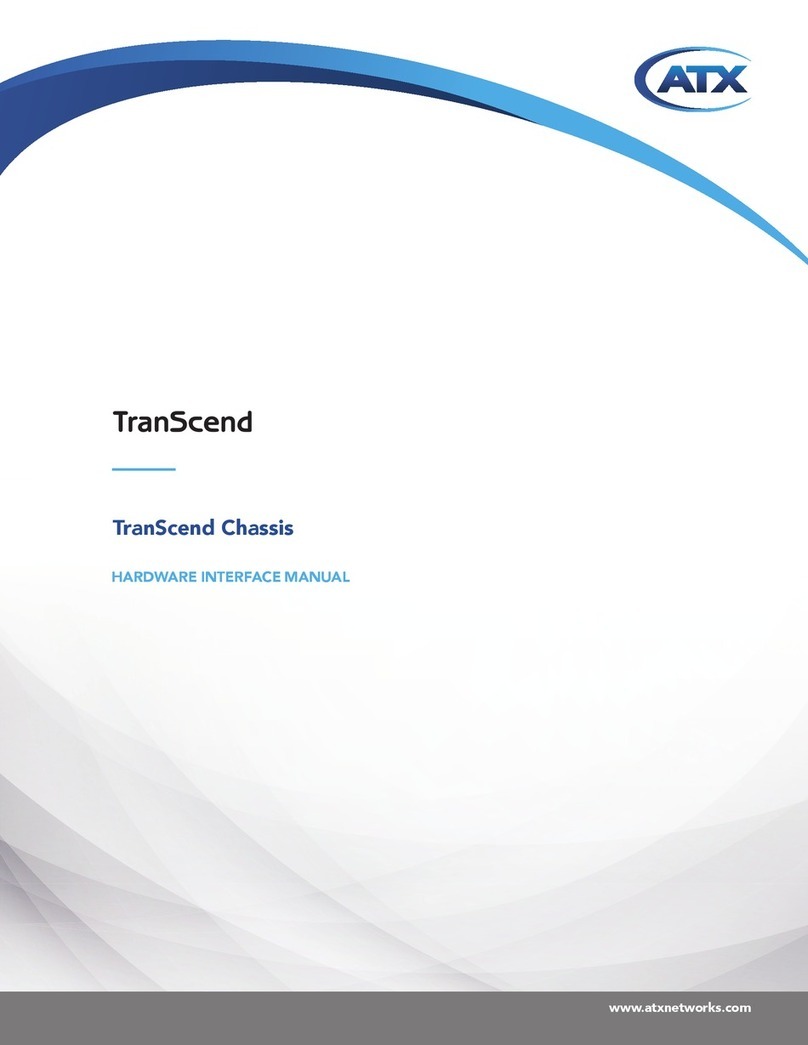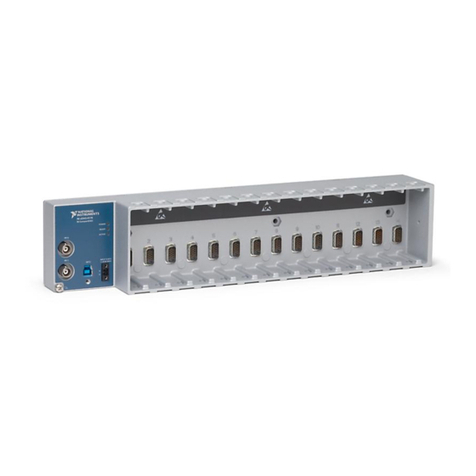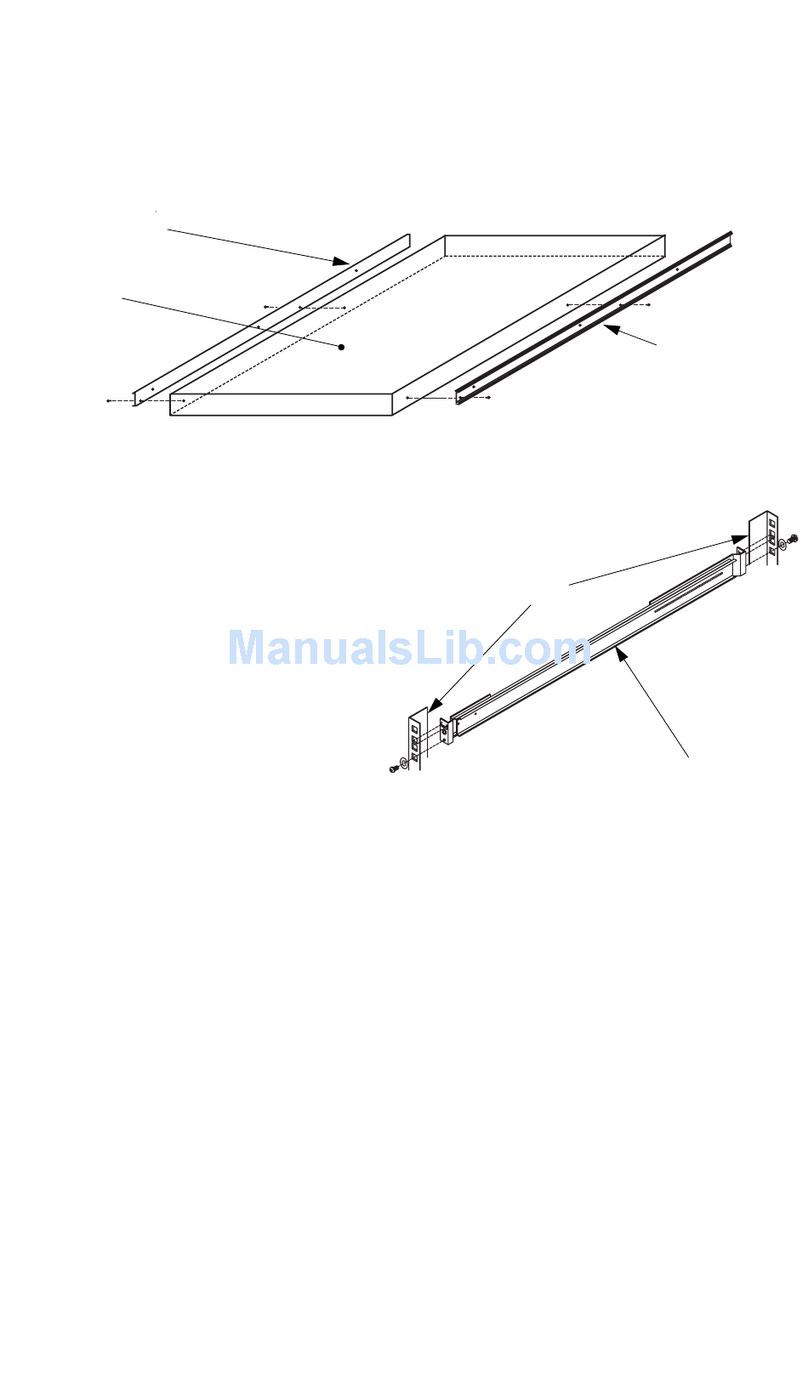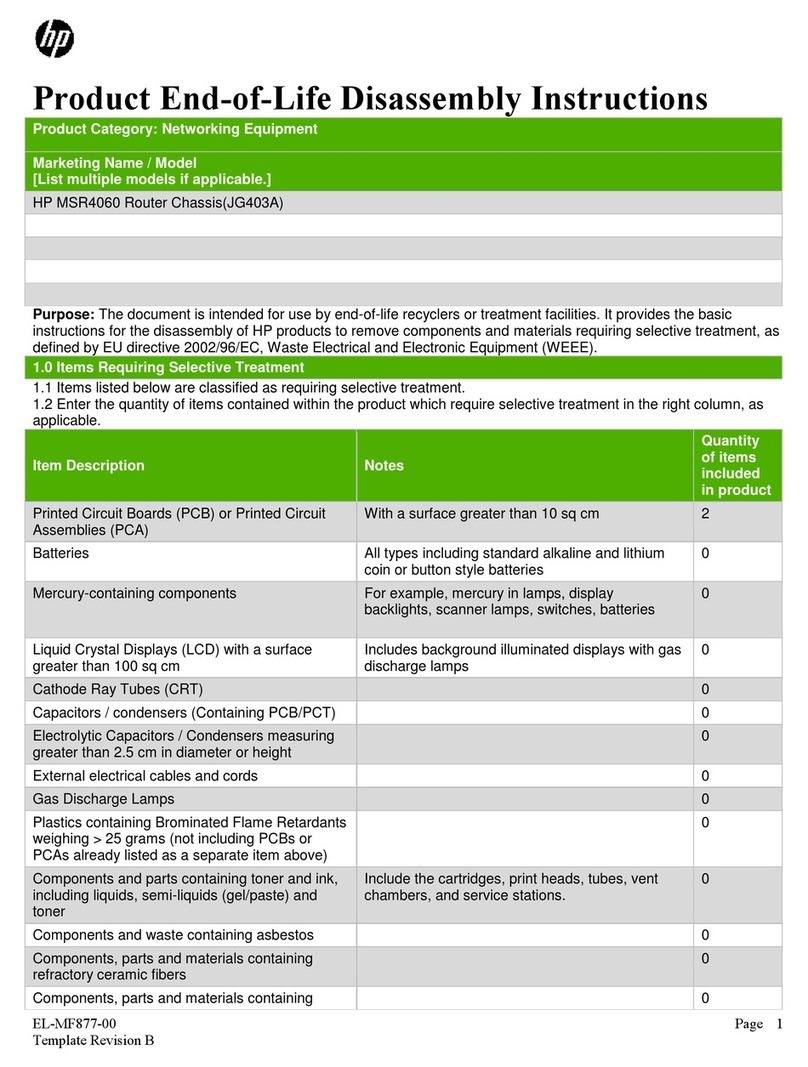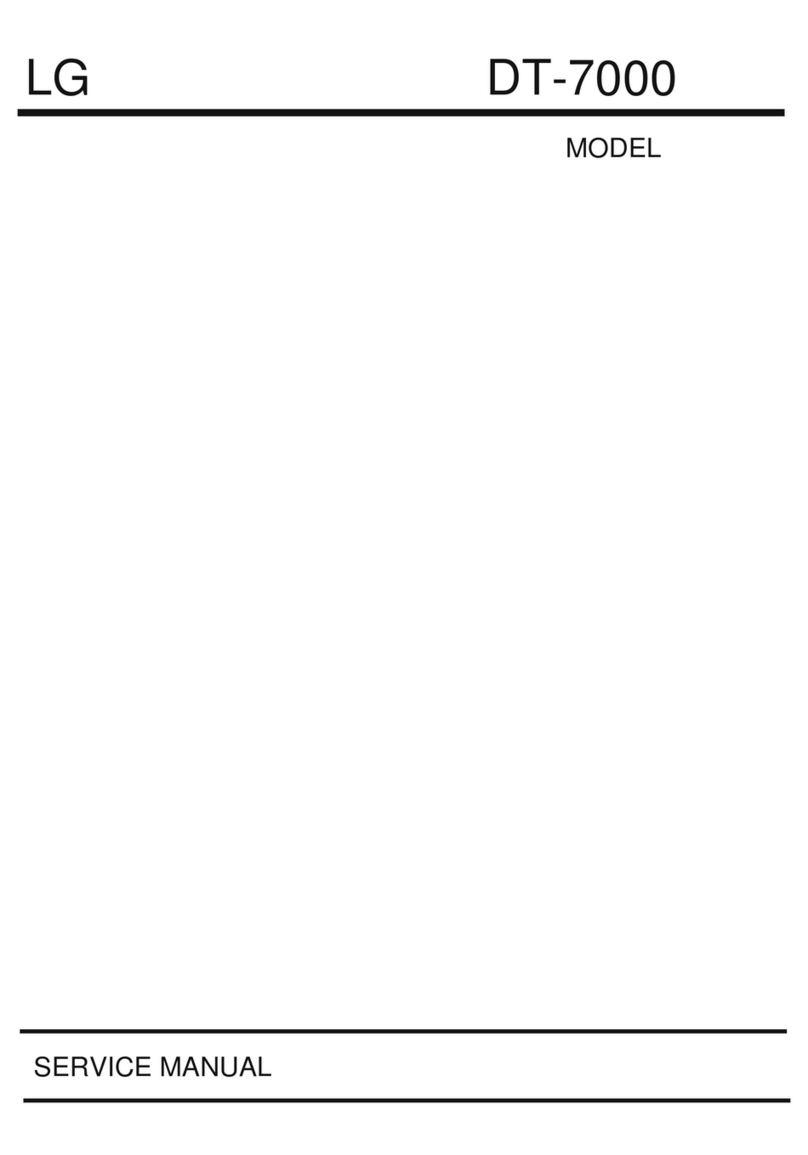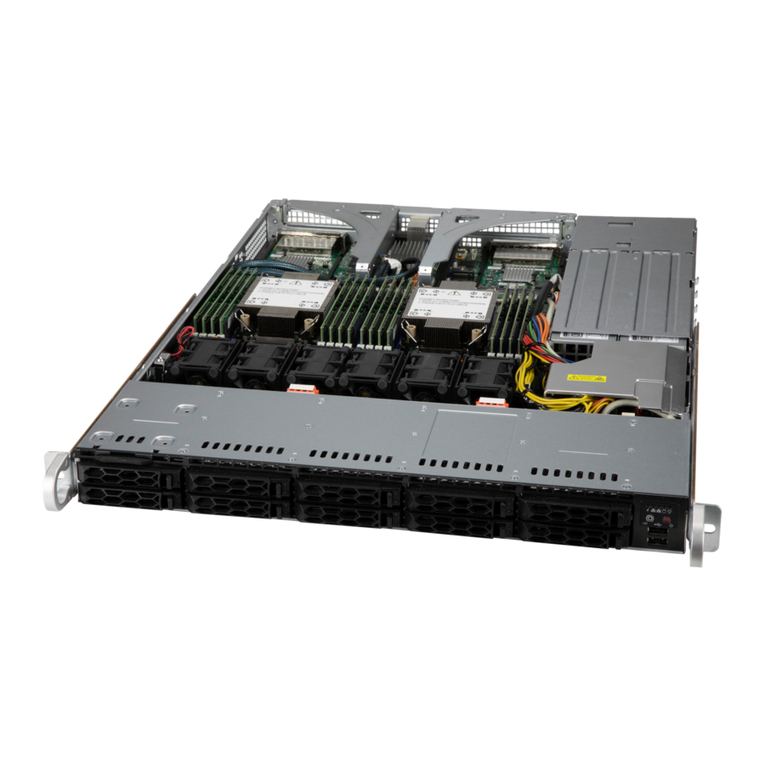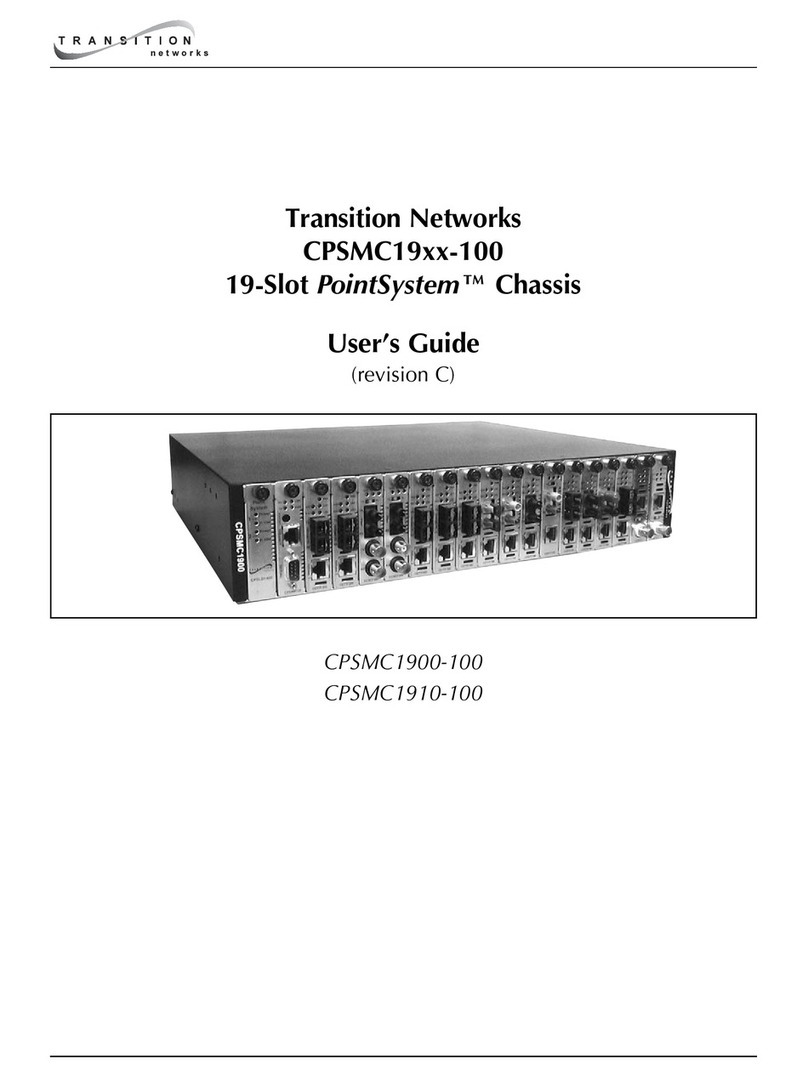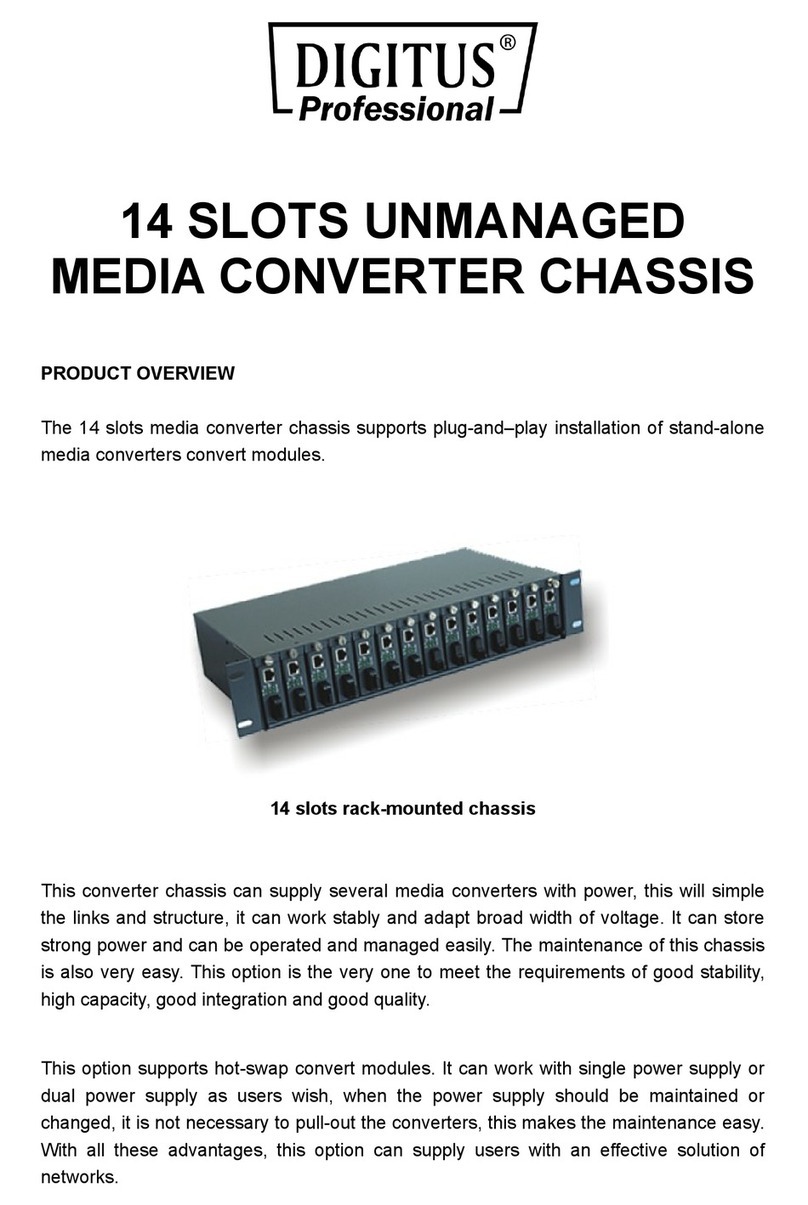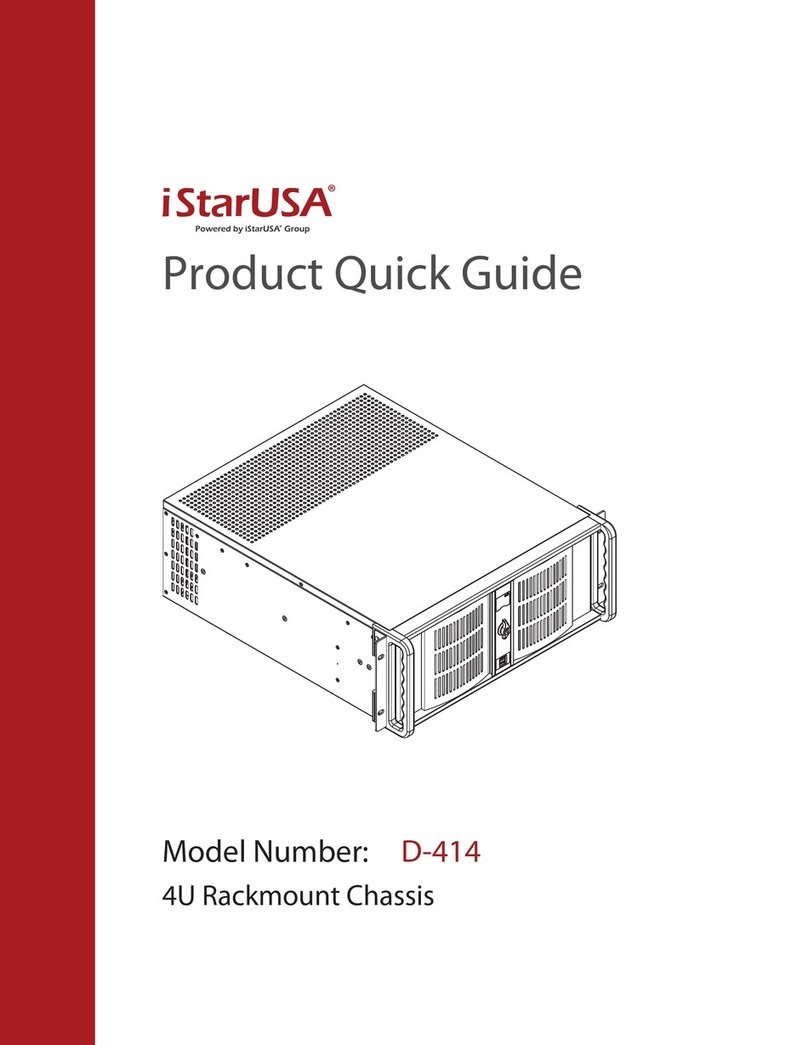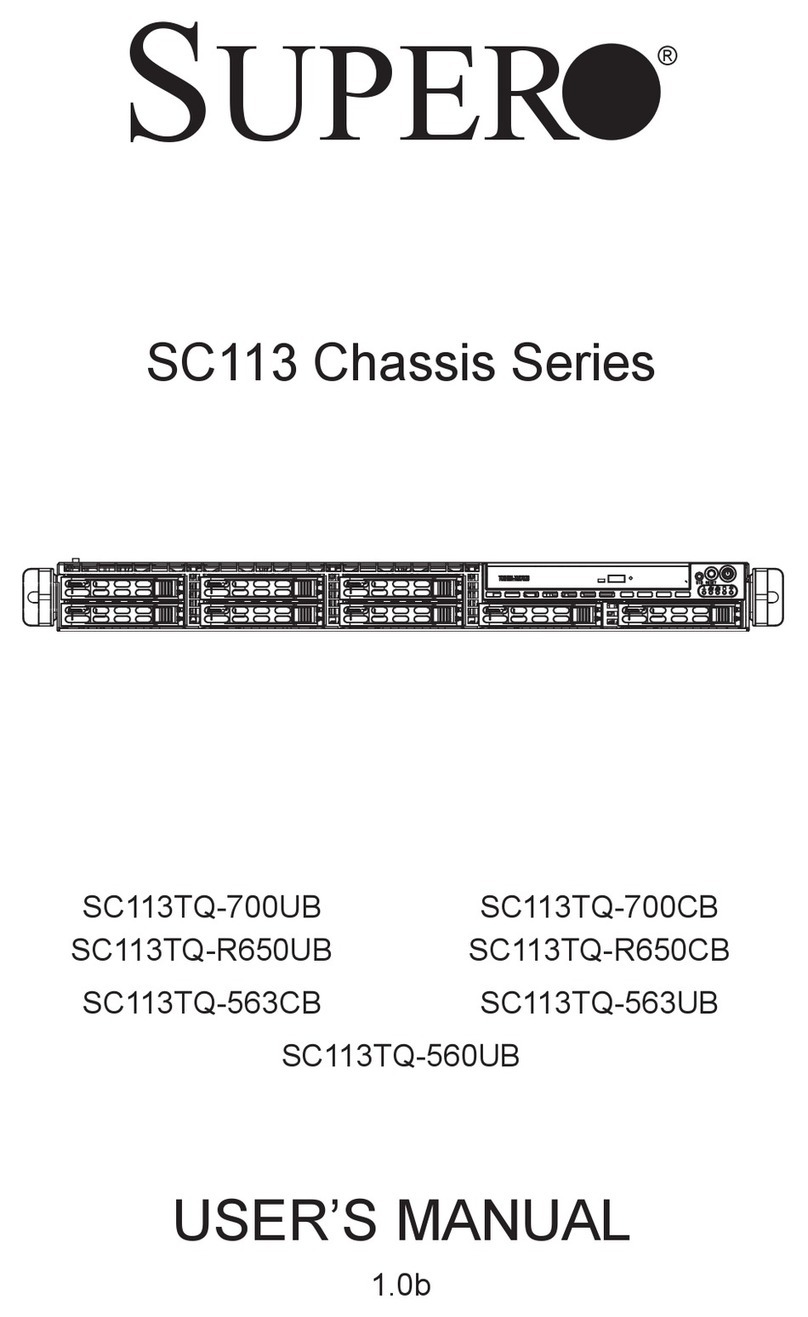ATX ChromaFlex User manual

OPERATION MANUAL
ChromaFlex Chassis
www.atxnetworks.com
www.atx.com
ChromaFlex
DISCONTINUED

Products or features contained herein may be covered by one or more U.S. or foreign patents. Other non-ATX product and company names in this manual are the property of their respective
companies.
Although every effort has been taken to ensure the accuracy of this document it may be necessary, without notice, to make amendments or correct omissions.
Specications subject to change without notice.

ChromaFlex Chassis – Operation Manual iii
ATX Condential & Proprietary
TABLE OF CONTENTS
1. SCOPE .............................................................. 1-1
2. LED DISPLAY ......................................................... 2-1
2.1 LED Color Codes ................................................. 2-1
2.2 Chassis Controller ................................................ 2-1
2.3 Plug-in Modules ................................................. 2-2
2.3.1 Chromadigm Chirp Cancelled Transmitter Module CCTX (CCT4/CCT2) . 2-2
2.3.2 Chromadigm Chirp Cancelled Transmitter Module CCT1 ............ 2-2
2.3.3 EDFA / AGC-EDFA / VG-EDFA ................................ 2-2
2.3.4 Quad Return Receiver (QRRX) ................................. 2-2
2.3.5 Optical Switch ............................................. 2-3
2.3.6 DMTx (DMT2 1310, DMT2 ITU, DMT3 1310, DMT3 ITU, DMT4 1310, DMT4 ITU) 2-3
3. HAND-HELD DISPLAY MODULE ......................................... 3-1
3.1 Connecting the Display Module ...................................... 3-1
3.2 Display Module Pushbutton Operations ................................ 3-1
3.2.1 Philosophy of Button Operations ............................... 3-2
3.2.2 Individual Button Operations .................................. 3-2
3.2.3 Combination Button Operations . . . . . . . . . . . . . . . . . . . . . . . . . . . . . . . . 3-2
3.3 Display Module LED Display ........................................ 3-3
3.3.1 Chassis System Menu Trees .................................. 3-3
3.3.2 Plug-in Application Module Menu Tree .......................... 3-4
3.3.2.1 Chromadigm Chirp Cancelled Transmitter Module CCTX (CCT4/CCT2) Tree
.......................................................... 3-5
3.3.2.2 Chromadigm Chirp Cancelled Transmitter Module CCT1 Tree ....... 3-7
3.3.2.3 EDFA / AGC-EDFA / VG-EDFA Menu Tree ..................... 3-10
3.3.2.4 Quad Return Receiver (QRRX)............................... 3-12
3.3.2.5 Optical Switch ........................................... 3-14
3.3.2.5.1 Optical Switch Switching Criteria ........................... 3-15
3.3.2.6 DMTX (DMT2 1310, DMT2 ITU, DMT3 1310, DMT3 ITU, DMT4 1310, DMT4 ITU) .
......................................................... 3-16
4. CRAFT LINE INTERFACE (CLI)........................................... 4-1
4.1 Command Structure ............................................... 4-1
4.1.1 Chassis System Commands.................................... 4-2
4.1.2 Plug-in Application Module Commands ........................... 4-7
4.1.3 Common Plug-in Module Information ............................. 4-7
4.1.3.1 Chromadigm Chirp Cancelled Transmitter Module CCTX (CCT4/CCT2) 4-7
4.1.3.2 Chromadigm Chirp Cancelled Transmitter Module CCT1 .......... 4-10
4.1.3.3 EDFA / AGC-EDFA. . . . . . . . . . . . . . . . . . . . . . . . . . . . . . . . . . . . . . . . 4-13
4.1.3.4 Quad Return Receiver (QRRX)............................... 4-14
4.1.3.5 Optical Switch ........................................... 4-15
4.1.3.6 DMTX (DMT3 1310, DMT3 ITU, DMT4 1310, DMT4 ITU) .............. 4-17
5. HTTP CONTROL PANEL INTERFACE ..................................... 5-1
5.1 System Login Page. . . . . . . . . . . . . . . . . . . . . . . . . . . . . . . . . . . . . . . . . . . . . . . . 5-1
5.2 Home Page...................................................... 5-2
5.3 Chassis Status Page .............................................. 5-3

iv ChromaFlex Chassis – Operation Manual
ATX Condential & Proprietary
5.3.1 Status, Chassis Model Banner .................................. 5-3
5.3.2 Status, Slots Banner.......................................... 5-3
5.4 Chassis Alarm Page ............................................... 5-4
5.4.1 Alarm, Chassis Model Banner .................................. 5-4
5.4.2 Alarm, Slots Banner .......................................... 5-4
5.5 Slot View Information & Alarm Page................................... 5-5
5.5.1 Factory Information Banner .................................... 5-5
5.5.2 Status Banner............................................... 5-5
5.5.3 Alarm Banner ............................................... 5-6
5.6 Slot Provision Page ............................................... 5-6
5.6.1 Provision for Release 4.4 & Older ............................... 5-6
5.6.2 Response .................................................. 5-7
5.6.3 Provision for Release 4.5 & Later................................ 5-7
5.6.4 Response .................................................. 5-8
5.6.5 Conguration Example (based on release 4.5 & later) .................. 5-9
5.6.6 Conguring a CCT4 Gain Control Example (based on release 4.4 & older) . 5-10
5.7 System Command Page........................................... 5-12
5.7.1 System Command Page for Release 4.4 & Older .................. 5-12
5.7.2 System Command Page for Release 4.5 & Later................... 5-12
5.7.3 Example for System Command Page for Release 4.4 & Older ........ 5-13
5.7.4 Example for System Command Page for Release 4.5 & Later. . . . . . . . . 5-14
5.8 HTTP Troubleshoot Guide ......................................... 5-15
6. USER INTERFACE CROSS REFERENCE .................................. 6-1
6.1 Chassis Attributes................................................. 6-1
6.2 Plug-in Module Attributes ........................................... 6-1
6.2.1 Chromadigm Chirp Cancelled Transmitter Module (CCT4/CCT2) Attributes ...
.......................................................... 6-1
6.2.2 Chromadigm Chirp Cancelled Transmitter Module CCT1 Attributes ..... 6-2
6.2.3 EDFA / AGC-EDFA / VG-EDFA Attributes .......................... 6-2
6.2.4 Quad Return Receiver Module (QRRX) Attributes.................... 6-2
6.2.5 Optical Switch Attributes....................................... 6-3
6.2.6 DMTX (DMT2 1310, DMT2 ITU, DMT3 1310, DMT3 ITU, DMT4 1310, DMT4 ITU) 6-3
7. SNMP ENTERPRISE ATTRIBUTES........................................ 7-1
8. SERVICE & SUPPORT.................................................. 8-1
8.1 Contact ATX Networks ............................................. 8-1
8.2 Warranty Information .............................................. 8-1

SCOPE
ChromaFlex Chassis – Operation Manual 1-1
ATX Condential & Proprietary
SCOPE
1. Scope
This document describes the user interfaces for ChromaFlex chassis and associated plug-in application modules. The user
interfaces include chassis and application module front panel LEDs, the hand-held display module’s button operations and
LCD display, Craft Line Interfaces and remote monitoring through SNMP and Graphical User Interface.
CHAPTER 1:

SCOPE
1-2 ChromaFlex Chassis – Operation Manual
ATX Condential & Proprietary
This page intentionally left blank.
CHAPTER 1:

LED DISPLAY
ChromaFlex Chassis – Operation Manual 2-1
ATX Condential & Proprietary
LED DISPLAY
2. LED Display
The chassis has a single status LED on the controller module and each plug-in application module has module specic
LEDs that are visible from the front panel. The LED trigger conditions shall be included in each individual module chapters.
2.1 LED Color Codes
There are four possible colors of LEDs. They are observed during the following conditions.
Off: indicates the monitored function is unavailable. This is also observed temporarily during power on LED test.
Green: indicates the monitored function is healthy. This is also temporarily observed during power on LED test.
Amber: indicates the monitored function is in minor alarm condition. This is also temporarily observed during power on LED
test.
Red: indicates the monitored function is in major alarm condition. This is also observed temporarily during power on LED
test.
Power up LED test:
At the beginning of each power up of all modules, the color of all LEDs turns from Red, Yellow to Green.
Figure 1: Generic Alarm & LED Table
2.2 Chassis Controller
The chassis controller module contains the system software and provides the user access to provision and monitor the
chassis and plug-in application modules. The controller is responsible for reporting the chassis and plug-in module related
status and alarm conditions. The chassis related alarms are reected on the controller module front panel Status LED.
LED Trigger Events
Status Power supply
Fan
Module temperature
CHAPTER 2:

LED DISPLAY
2-2 ChromaFlex Chassis – Operation Manual
ATX Condential & Proprietary
2.3 Plug-in Modules
2.3.1 Chromadigm Chirp Cancelled Transmitter Module CCTX (CCT4/CCT2)
The Chromadigm Chirp Cancelled Transmitter Module CCTX (CCT4/CCT2) has four pairs of LEDs on the front panel
marked with their associated ITU channel 1 to 4.
The CCTX detects the alarms and reects them on the front panel LEDs based on the following schema.
LED Trigger Events
OPT Laser temperature
Output power (Laser Power)
Module temperature
RF RF
Example #1: The module temperature is normal, but the laser temperature is at a level that indicates a major alarm. The top
LED associated with the interface shall be observed as “red”.
2.3.2 Chromadigm Chirp Cancelled Transmitter Module (CCT1)
The Chromadigm Chirp Cancelled Transmitter Module (CCT1) and CCT1 variance have one pairs of LEDs on the front
panel marked with their associated ITU channel 1.
The CCT1 detects the alarms and reects them on the front panel LEDs based on the following schema.
LED Trigger Events
OPT Laser temperature
Output power
Module temperature
RF RF
Example #1: The module temperature is normal, but the laser temperature is at a level that indicates a major alarm. The top
LED associated with the interface shall be observed as “red”.
2.3.3 EDFA / AGC-EDFA / VG-EDFA
The EDFA detects the alarms and reects them on the front panel LEDs based on the following schema.
LED Location Trigger Events
Status Module temperature
IN Optical input power
OUT EDFA: Optical output power
AGC-EDFA: Gain
Example #1: The optical input power is at a level that indicates a major alarm. The IN LED shall be observed as “red”.
2.3.4 Quad Return Receiver (QRRX)
The Quad Return Receiver (QRRX) detects the alarms and reects them on the front panel LEDs based on the following
schema.
LED Location Trigger Events
Status Module temperature
1-4 Optical input power
Example #1: The optical input power #1 is at a level that indicates a major alarm. The #1 LED shall be observed as “red”.
CHAPTER 2:

LED DISPLAY
ChromaFlex Chassis – Operation Manual 2-3
ATX Condential & Proprietary
2.3.5 Optical Switch
The Optical Switch detects the alarms and reects them on the front panel LEDs based on the following schema.
LED Location Trigger Events
Status Alarm(s) triggered by switch alarm and/or module temp alarm
PRI Opt In Pwr level crosses alarm thresholds
SEC Opt In Pwr level crosses user settable thresholds
Example #1: The module temperature is normal, but switch is major. The top LED associated with the slot shall be observed
as “red”.
2.3.6 DMTx (DMT2 1310, DMT2 ITU, DMT3 1310, DMT3 ITU, DMT4 1310, DMT4 ITU)
The DMTx detects the alarms and reects them on the front panel LEDs based on the following schema. For DMT3
modules, there are three pairs of LEDs (OPT on top and RF on bottom) and DMT4 modules, there are four pairs of LEDs.
LED Trigger Events
OPT (Top) Laser temperature
Laser power
Module temperature
RF (Bottom) RF
Example #1: The module temperature is normal, but the laser temperature is at a level that indicates a major alarm. The top
LED associated with the interface shall be observed as “red”.
CHAPTER 2:

LED DISPLAY
2-4 ChromaFlex Chassis – Operation Manual
ATX Condential & Proprietary
This page intentionally left blank.
CHAPTER 2:

HAND-HELD DISPLAY MODULE
ChromaFlex Chassis – Operation Manual 3-1
ATX Condential & Proprietary
HAND-HELD DISPLAY MODULE
3. Hand-held Display Module
An optional Hand-held Display Module (referred as “Display Module” in this manual) allows you to monitor and control
the chassis and plug-in application modules locally through a special DB15 cable. All readable and writeable attributes
can be monitored and congured locally via the Display Module. When the Display Module is attached, the ChromaFlex
Controller module performs a reset as the controller connects to the Display Module. You may experience a momentarily
communication disruption when reading system attributes (i.e. power supply and fan alarms, module temperature reading,
etc.) during the reset process. There is no operational impact to the active plug-in application modules.
3.1 Connecting the Display Module
Connect the Display Cable to the female DB15 connector, labeled I-DISPLAY, on the face of ChromaFlex Controller module
and to the female DB15 connector on the Display Module. The ChromaFlex Controller performs a quick reboot when the
Display Module is connected. There is no impact on the active application modules during this reboot. You will observe the
ChromaFlex chassis greeting message when the reboot completes.
3.2 Display Module Pushbutton Operations
There are ve pushbuttons located on the Display Module. They are designated as “Up” with an upper arrow indicator,
“Right” with a right arrow indicator, “Left” with a left arrow indicator, “Down” with a down arrow indicator and “Select” as the
center button.
CHAPTER 3:

HAND-HELD DISPLAY MODULE
3-2 ChromaFlex Chassis – Operation Manual
ATX Con dential & Proprietary
3.2.1 Philosophy of Button Operations
The button operations are similar to those of other systems designed and manufactured by ATX.
3.2.2 Individual Button Operations
Up: the cursor moves up one line
Down: the cursor moves down one line
Right: cycle through the available options for the line where cursor is located.
If the menu is for a read-only attribute, the display shows the next available interface.
Example #1:
If the current display is “#1 Optical Power”, the “#2 Optical Power” shall be displayed after “Right” button is pressed.
Example #2:
If the menu is for a con gurable attribute, the “Right” button increases the value.
In the “Gain Setting Menu”, the cursor displays Gain (steps): 1, the Gain (steps): 2 shall be displayed after the “Right” button
is pressed once.
Left: cycle through the available options for the line where cursor is located
If the menu is for a read-only attribute, the display shows the previous available interface.
Example #1:
If the current display is “#2 Optical Power”, the “#1 Optical Power” shall be displayed after “Left” button is pressed.
Example #2:
If the menu is for a con gurable attribute, the left button decreases the value.
In the “Gain Setting Menu”, the cursor displays Gain (steps): 3, the Gain (steps): 2 shall be displayed after “Left” button is
pressed.
Select: There are multiple meanings to the select button.
Select to execute the action where the cursor is located.
Example #1:
If the cursor is located at the “Prev menu” line, the display shall change to the NEXT higher menu after the “Select” button is
pressed once.
Select to commit a selected option.
Example #1:
In the “Gain Setting Menu”, if the cursor is located on the “Sel Ch: 1” line, the channel #1 shall be used for gain adjustment
after the “Select” button is pressed.
NOTE: Only after pressing the Select button, the gain settings option is performed on the selected
channel.
Select to commit the setting to NVRAM
Example #1:
In the “Gain Setting Menu”, if the cursor is on “Save: No (17)”, user must toggle the left/right buttons to change the option to
“Yes”. Then press “Select” to commit the value, 17, in the bracket into the NVRAM.
NOTE: Only if the value is committed into NVRAM, the chassis will use the selected gain level next
time the chassis recovers from power cycle.
3.2.3 Combination Button Operations
UP+DOWN: When pressing and holding the UP+DOWN button simultaneously while traversing the slot menu, the front
panel displays the current slot number. The front panel display will restore back to the previous display once the button
combination is released.
CHAPTER 3:

HAND-HELD DISPLAY MODULE
ChromaFlex Chassis – Operation Manual 3-3
ATX Condential & Proprietary
Example #1: User is within the “Status Menu” of slot #1, press and hold the Up and Down buttons, the front panel displays
“Current Slot: 1”. The “Status Menu” returns after releasing the Up and Down button combinations.
LEFT+RIGHT: When pressing and holding the LEFT+RIGHT button simultaneously, the front panel will display the tree’s top
menu of the current sub-tree. The top menu is usually the module’s Greetings.
3.3 Display Module LCD Display
This section describes the Display Modules LCD display menu tree structure and specic menus associated with the
ChromaFlex chassis and ChromaFlex plug-in application modules.
The Display Modules LCD menu for the ChromaFlex chassis is structured into tri-level tree. The top level (Level 1) is the
system Greeting. Level 2 is where you select either the Chassis related information or a slot and Level 3 displays the
selected system level information for the chassis or greeting menu of the selected slot.
3.3.1 Chassis System Menu Trees
The ChromaFlex chassis LCD menu is structured into bi-level trees. The top level is system related information and the
second level is plug-in related information. The top level contains the menu for second level, but each has its own menu
structure.
Level 1 Level 2 Level 3
Greeting Slot
Status Voltage (V)
Chassis Mod Temp
Model
Hardware Version
Software Version
Serial Number
Prev Menu
Alarm Power Supply
Fan
Prev Menu
Prev Menu
Table 1: ChromaFlex System Menu Overview
The Display Module displays the greeting message when connected to the controller module and the initial reset has
completed.
Greeting:
Press the “Select” button to go into the system menus. The entries in system menus are described as follows:
Numbered Slot:
This displays the detected plug-in card type or “Empty” if none is detected. Press “Right” or “Left” button to cycle through
available slots. Press “Select” to select an individual slot (module) menu. If the communication with slot establishes
successfully, the display will go into the Module Greeting menu. Keep in mind that the slot numbering scheme is from 1 to 8.
ATX Networks
ChromaFlex
CHAPTER 3:

HAND-HELD DISPLAY MODULE
3-4 ChromaFlex Chassis – Operation Manual
ATX Condential & Proprietary
Slot Status:
Module Greeting: communication is established with the plug-in application module.
Empty: no module is detected in the slot.
Failed to Switch: cannot establish communication with the module.
Multi-slot unit; Display avail on slot #: this is the virtual slot on a multiple slot unit. User can access the module’s
display menu via the lowest slot of the multi slot unit. The slot # is shown.
Status:
Display all system status related information.
Voltage (V): displays the chassis on board voltage.
Chassis:
Displays chassis related information.
Mod Temp (C): displays the chassis module temperature readings in Centigrade.
Model: displays the chassis’ model name.
HW Ver: displays the hardware version information of ChromaFlex chassis.
SW Ver: displays the software version information of ChromaFlex chassis.
Ser #: displays the serial number of ChromaFlex chassis.
Alarm:
Displays chassis related alarm status.
Pwr Sply: displays the health of chassis power supply.
Mod Temp: displays the health of chassis temperature.
Fan: displays the collective health of the chassis fans.
Prev Menu:
Press “Select” will navigate you back to the Greeting Message. Note: “Prev Menu” exists at the bottom of all menu trees.
Place the cursor on this line and press the “Select” button to navigate back to the previous menu.
3.3.2 Plug-in Application Module Menu Tree
The plug-in application module menu displays the modules status and conguration options associated with the specic
module type. Each module type provides its own display structure. In any sub menu, press “Select” on the Prev Menu line
to return to the option menu for the chassis system.
CHAPTER 3:

HAND-HELD DISPLAY MODULE
ChromaFlex Chassis – Operation Manual 3-5
ATX Condential & Proprietary
3.3.2.1 Chromadigm Chirp Cancelled Transmitter Module CCTX (CCT4/CCT2) Tree
Level 1 Level 2 Level 3 Level 4
InnoTrans
CCTX
Setup Mode Setting Mode
Save
Prev Menu
Gain Setting RF Lvl(rdB)
Gain(Steps)
Save
Prev Menu
Prev Menu
Tx Status Opt
RF
Att(dB)
Mode
Prev Menu
Alarm Laser Temperature
Output Pwr
RF Level
Unit Temp
Prev Menu
Status Temp(C)
Power(mW)
Power(dBm)
RF Lvl(dB)
Lambda(nm)
Voltage(V)
Prev Menu
Chassis Temperature(C)
Model
Hardware Version
Software Version
Serial Number
Prev Menu
Prev Menu
Table 2: ChromaFlex CCTX Display Menu Overview
CHAPTER 3:

HAND-HELD DISPLAY MODULE
3-6 ChromaFlex Chassis – Operation Manual
ATX Con dential & Proprietary
Greeting:
After a valid slot is selected from the option menu of Chassis, a greeting menu of the selected module will be shown; in this
case, it is “CCTX”.
Greeting Message
Setup Menu:
Mode Setting
Mode: use the right or left bottom to toggle the mode to “AGC” or “MGC” mode.
Save: use the right or left bottom to toggle the NVRAM mode to “Yes” to save and press select to store the setting
in the NV RAM.
NOTE: Failing to do so may result in the loss of the setting after a power cycle.
Gain Setting
RF Lvl(rdB): current RF level reading in rdB (relative dB).
Gain: use the right or left bottom to step up or down the gain.
Save: use the right or left bottom to toggle the NVRAM mode to “Yes” to save and press select to store the setting
in the NV RAM.
NOTE: Failing to do so may result in the loss of the setting after a reboot/power cycle.
Tx Status Menu:
This display conveniently presents all available channels in one line.
Opt: displays the optical output power in dBm to each ITU transmitter channel.
RF: displays RF input level reading in dB to each ITU transmitter channel.
Attn: displays the reading of reserve attenuation in dB.
Mode: displayed the current mode AGC or MGC.
Alarm Menu: Displays the status of each ITU channel. Use left/right buttons to select a particular transmitter ITU channel
for per channel items. Available channel numbers are 1 to 4 or highest available channel.
Laser Temp: displays the alarm status of laser temperature.
Output Pwr: displays the alarm status of the laser output power.
RF Level: displays the alarm status of the RF level.
Module Temp: displays the alarm status of module temperature.
Status Menu: Displays the status of each ITU channel. Use left/right buttons to select a particular transmitter ITU channel
for per channel items. Available channel numbers are 1 to 4 or highest available channel.
Temp (C): displays the reading of laser temperature in Centigrade.
Power (mW): displays the reading of optical power in milliwatts.
Power (dBm): displays the reading of optical power in dBm.
RF Lvl (dB): displays the reading of RF level in dB.
Lambda (nm): displays the reading of wavelength in nanometer.
Voltage (V): displayed the on board supply voltage.
ATX Networks
CCTX
CHAPTER 3:

HAND-HELD DISPLAY MODULE
ChromaFlex Chassis – Operation Manual 3-7
ATX Condential & Proprietary
Chassis Menu:
Temp(C): displays the module’s temperature reading in Centigrade.
Model: displays the model name of plug-in module.
HW Ver: displays the hardware version information of plug-in module.
SW Ver: displays the software version information of plug-in module.
Ser #: displays the serial number of plug-in module.
Prev Menu:
Press “Select” will bring the plug-in’s greeting message screen back.
3.3.2.2 Chromadigm Chirp Cancelled Transmitter Module (CCT1) Tree
There are multiple versions of CCT1, with constant output power (CCT1) or with variable output power (CCT1-VO) or with
xed output power (CCT1-FO). User can use the OPTOut adjustment to manually increase/decrease the output power level
on the CCT1-VO.
Level 1 Level 2 Level 3 Level 4
Greeting Setup Mode Setting Mode
Save
Prev Menu
Gain Setting RF Lvl(rdB)
Gain(Steps)
Save
Prev Menu
OPTOut OPTOut (dBm)
OPTOut (dBm)
Save
Prev Menu
Prev Menu
Tx Status Opt
RF
Mode
Prev Menu
CHAPTER 3:

HAND-HELD DISPLAY MODULE
3-8 ChromaFlex Chassis – Operation Manual
ATX Con dential & Proprietary
Alarm Laser Temperature
OPT Out Pwr
RF Level
Module Tmp
Prev Menu
Status Laser Temp(C)
OPT Out (dBm)
Att(dB)
RF Lvl(dB)
Lambda(nm)
Voltage(V)
Prev Menu
Chassis Temperature(C)
Model
Hardware Version
Software Version
Serial Number
Prev Menu
Prev Menu
Table 3: ChromaFlex CCT1 Display Menu Overview
Greeting:
After a valid slot is selected from the option menu of Chassis, a greeting menu of the selected module will be shown; in this
case, it is “CCT1”. For CCT1 with variable output, this would read “CCT1-VO”.
Greeting Message:
Setup Menu:
Mode Setting
Mode: use the right or left bottom to toggle the mode to “AGC” or “MGC” mode.
Save: use the right or left bottom to toggle the NVRAM mode to “Yes” to save and press select to store the setting
in the NV RAM.
NOTE: Failing to do so may result in the loss of the setting after a reboot/power cycle.
Gain Setting
RF Lvl(rdB): current RF level reading in rdB (relative dB).
Gain: use the right or left bottom to step up or down the gain.
Save: use the right or left bottom to toggle the NVRAM mode to “Yes” to save and press select to store the setting
in the NV RAM.
ATX Networks
CCT1
CHAPTER 3:

HAND-HELD DISPLAY MODULE
ChromaFlex Chassis – Operation Manual 3-9
ATX Con dential & Proprietary
NOTE: Failing to do so may result in the loss of the setting after a reboot/power cycle.
OPTOut Setting
This menu only appears on CCT1-VO module.
OPTOut (dBm): displays the readback of optical output power in dBm. This information is displayed to aide user
while adjusting the output power.
OPTOut(dBm): adjustment of output power level. Use the right or left to toggle through available options.
Save: use the right or left bottom to toggle the NVRAM mode to “Yes” to save and press select to store the setting
in the NV RAM.
NOTE: Failing to do so may result in the loss of the setting after a reboot/power cycle.
Tx Status Menu:
This display conveniently presents all available channels in one line.
Opt: displays the optical output power in dBm to each ITU transmitter channel.
RF: displays RF input level reading in dB to each ITU transmitter channel.
Mode: displayed the current mode AGC or MGC.
Alarm Menu:
Laser Temp: displays the alarm status of laser temperature.
Output Pwr: displays the alarm status of the optical output power.
RF Level: displays the alarm status of the RF level.
Module Temp: displays the alarm status of module temperature.
Status Menu:
Laser Tmp (C): displays the reading of laser temperature in Centigrade.
RF Lvl (dB): displays the reading of RF level in dB.
OPT Out (dBm): displays the reading of Optical output power in dBm.
Att (dB): displays the reading of attenuation in dB.
Lambda (nm): displays the reading of wavelength in nanometer.
Voltage (V): displayed the on board supply voltage.
Chassis Menu:
Temp(C): displays the module’s temperature reading in Centigrade.
Model: displays the model name of plug-in module.
HW Ver: displays the hardware version information of plug-in module.
SW Ver: displays the software version information of plug-in module.
Ser #: displays the serial number of plug-in module.
Prev Menu:
Press “Select” will bring the plug-in’s greeting message screen back.
CHAPTER 3:

HAND-HELD DISPLAY MODULE
3-10 ChromaFlex Chassis – Operation Manual
ATX Condential & Proprietary
3.3.2.3 EDFA / AGC-EDFA / VG-EDFA Menu Trees
There are multiple versions of EDFA; EDFA, EDFA with Adjustable Gain Control and EDFA with adjustable attenuation (i.e.
VOA).
Level 1 Level 2 Level 3 Level 4
Greeting Setting Mode Mode
Save
Prev
Gain Gain
Save
Prev
OPTOut OPTOut (dBm)
OPTOut (dBm)
Save
Prev
Status OPT In (dBm)
OPT Out (dBm)
Gain(dB)
Voltage (V)
Prev Menu
Alarm OPT In Pwr
OPT Out Pwr
Module Temp
Prev Menu
Chassis Tmp(C)
Model
HW Ver
SW Ver
Ser #
Prev Menu
Prev Menu
Table 4: ChromaFlex AGC-EDFA Display Menu Overview
Greeting:
After a valid slot is selected from the option menu of Chassis, a greeting menu of the selected module will be shown; in this
case, it is “EDFA”. For the EDFA with AGC, this would read “AGC-EDFA” and for the EDFA with VOA, this would read “VG-
EDFA”.
Greeting Message:
ATX Networks
EDFA
CHAPTER 3:
Table of contents
Other ATX Chassis manuals
Popular Chassis manuals by other brands

Cisco
Cisco 5505 - ASA Firewall Edition Bundle Administrator's guide
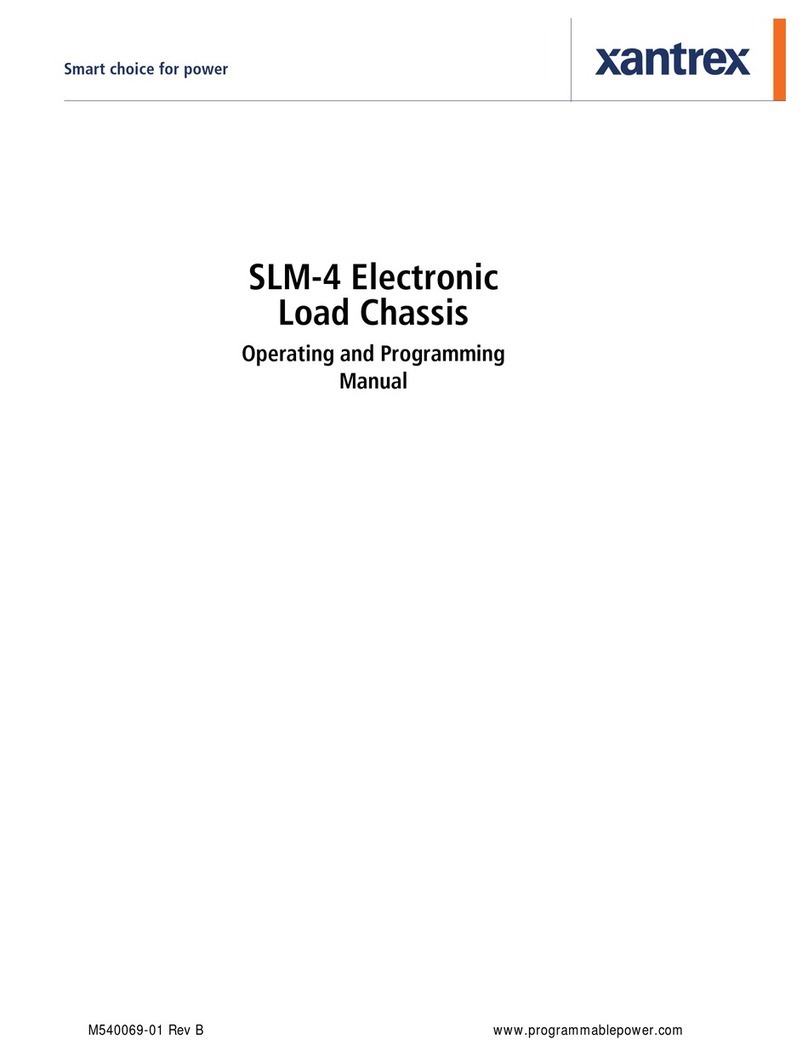
Xantrex
Xantrex SLM-4 Operating and programming manual
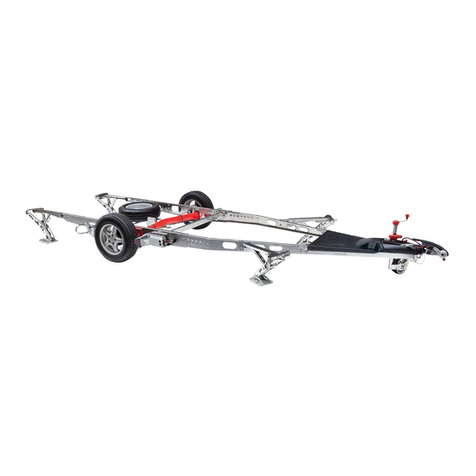
AL-KO
AL-KO CARAVAN CHASSIS Handbook
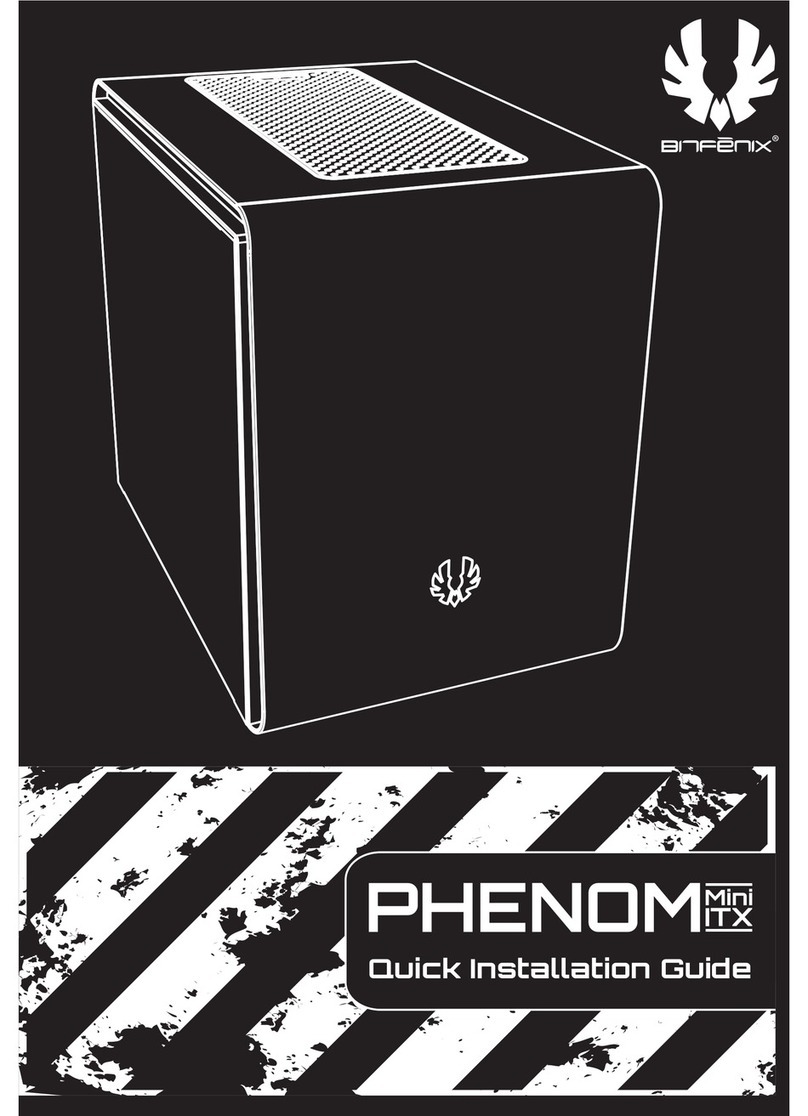
BitFenix
BitFenix phenom mini-itx Quick installaion guide
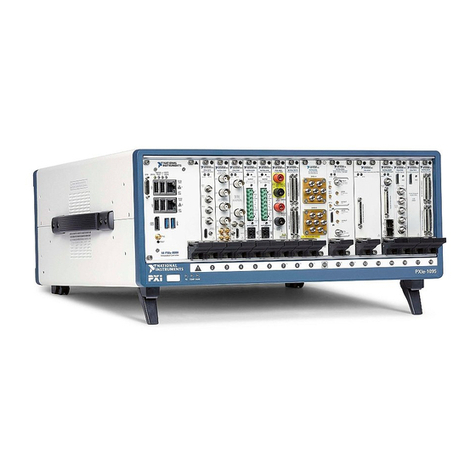
National Instruments
National Instruments PXI EXPRESS PXIe-1095 user manual
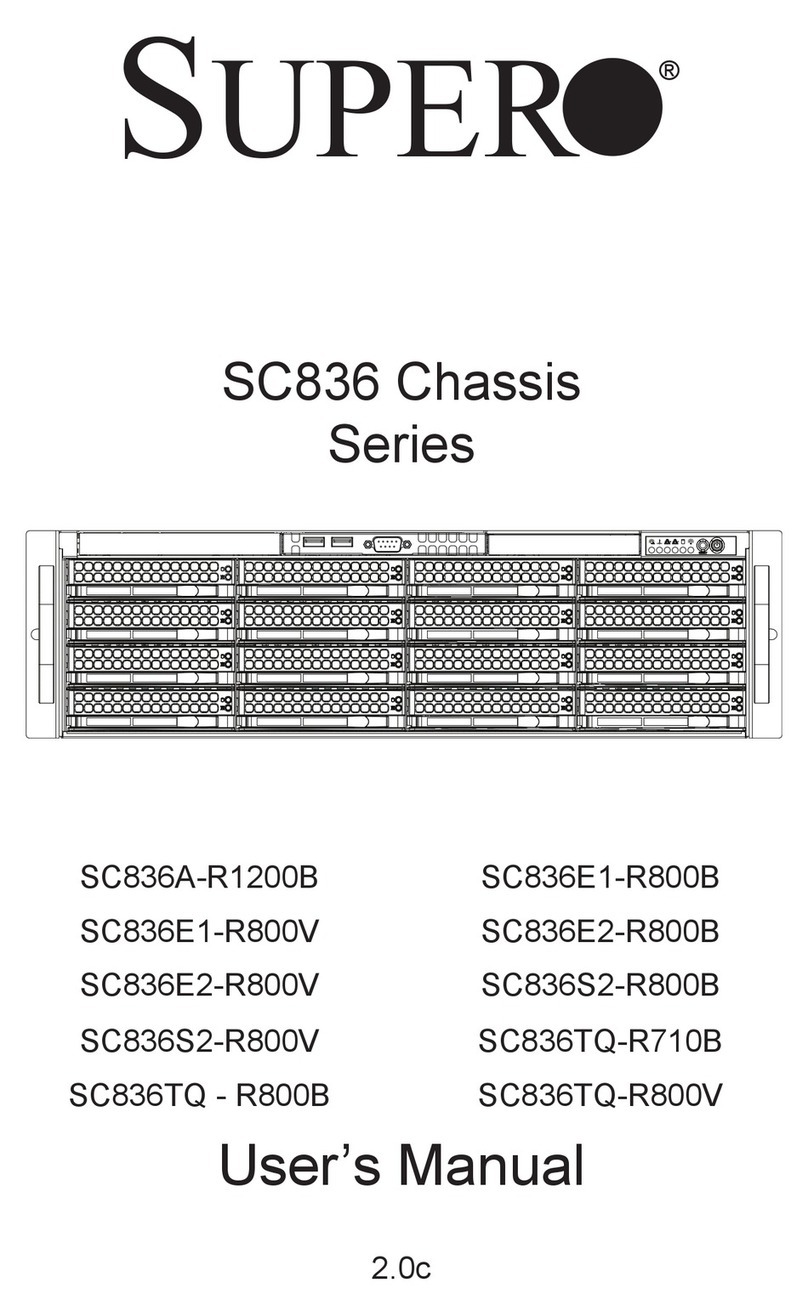
Supero
Supero SC836A-R1200B SC836E1-R800BSC836E1-R800V user manual
